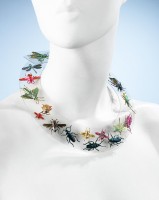ELSA SCHIAPARELLI
Эльза Скиапарелли
エルザ・スキャパレッリ
엘사 스키아파렐리
艾尔莎夏帕瑞丽
אלזה סקיאפרלי
source: brooklynmuseumorg
Elsa Schiaparelli (French, born Italy, 1890–1973). Necklace, autumn 1938. Clear Rhodoid (cellulose acetate plastic); metallic green, red, pink, blue, and yellow painted pressed metal ornaments. Brooklyn Museum Costume Collection at The Metropolitan Museum of Art, Gift of the Brooklyn Museum, 2009; Gift of Arturo and Paul Peralta Ramos, 1955 (2009.300.1234)
Rhodoid was a newly developed material that suited Elsa Schiaparelli’s design intent for this, perhaps her most macabre and certainly one of her most iconic designs. The transparent foundation creates the illusion that the insects are crawling directly on the skin of the wearer’s neck. Yet Schiaparelli was never too heavy-handed: her choice of brightly colored, toy-like ornaments tempers the repugnant effect.
.
.
.
.
.
.
source: metmuseumorg
From the fall 1938 pagan collection, this iconic necklace epitomizes Schiaparelli’s Surrealist tendencies, perhaps more than any other design she executed because of the unreal idea of insects crawling on your skin as a fashion statement. Because of the clear Rhodoid, a type of cellulose acetate plastic, the multicolored insects seem to be resting on the wearer’s skin. Rhodoid was a newly developed material and Schiaparelli was unafraid of using inventive materials for her designs. She appreciated the avant-garde quality and element of surprise infused into the design by using unconventional materials. The pagan collection was inspired by Botticelli’s lush paintings; therefore flowers, woodland creatures, foliage, and insects decorated dinner suits, evening gowns and accessories. The multicolored metal insects were also seen securing a ribbon hatband on a doll hat and resting on the collar of a suit (see 2009.300.2374a, b). This necklace was worn by Millicent Rogers (who also owned the suit previously mentioned), one of Schiaparelli’s best clients who was brave enough to wear her outré designs.


